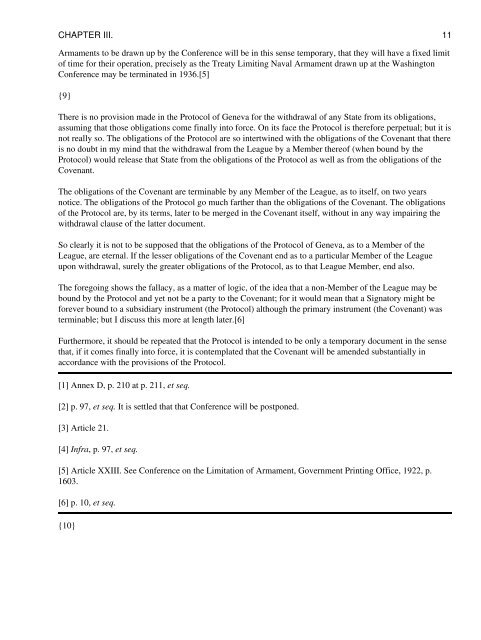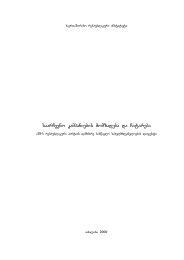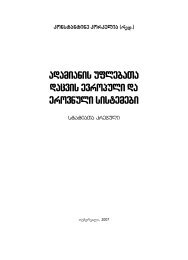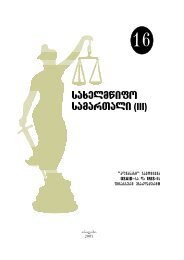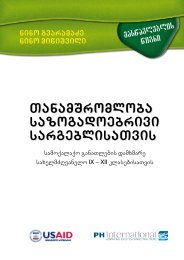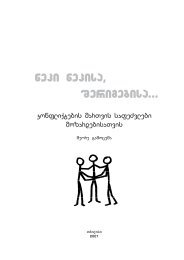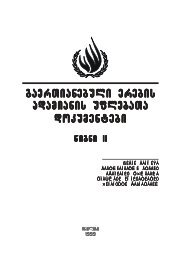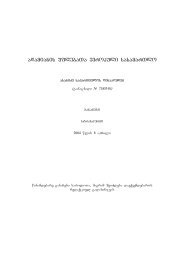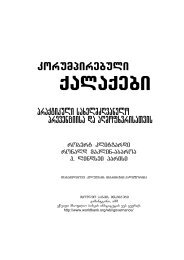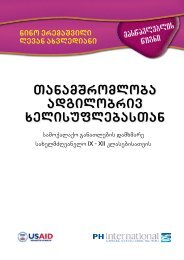The Geneva Protocol, by David Hunter Miller
The Geneva Protocol, by David Hunter Miller
The Geneva Protocol, by David Hunter Miller
You also want an ePaper? Increase the reach of your titles
YUMPU automatically turns print PDFs into web optimized ePapers that Google loves.
CHAPTER III. 11<br />
Armaments to be drawn up <strong>by</strong> the Conference will be in this sense temporary, that they will have a fixed limit<br />
of time for their operation, precisely as the Treaty Limiting Naval Armament drawn up at the Washington<br />
Conference may be terminated in 1936.[5]<br />
{9}<br />
<strong>The</strong>re is no provision made in the <strong>Protocol</strong> of <strong>Geneva</strong> for the withdrawal of any State from its obligations,<br />
assuming that those obligations come finally into force. On its face the <strong>Protocol</strong> is therefore perpetual; but it is<br />
not really so. <strong>The</strong> obligations of the <strong>Protocol</strong> are so intertwined with the obligations of the Covenant that there<br />
is no doubt in my mind that the withdrawal from the League <strong>by</strong> a Member thereof (when bound <strong>by</strong> the<br />
<strong>Protocol</strong>) would release that State from the obligations of the <strong>Protocol</strong> as well as from the obligations of the<br />
Covenant.<br />
<strong>The</strong> obligations of the Covenant are terminable <strong>by</strong> any Member of the League, as to itself, on two years<br />
notice. <strong>The</strong> obligations of the <strong>Protocol</strong> go much farther than the obligations of the Covenant. <strong>The</strong> obligations<br />
of the <strong>Protocol</strong> are, <strong>by</strong> its terms, later to be merged in the Covenant itself, without in any way impairing the<br />
withdrawal clause of the latter document.<br />
So clearly it is not to be supposed that the obligations of the <strong>Protocol</strong> of <strong>Geneva</strong>, as to a Member of the<br />
League, are eternal. If the lesser obligations of the Covenant end as to a particular Member of the League<br />
upon withdrawal, surely the greater obligations of the <strong>Protocol</strong>, as to that League Member, end also.<br />
<strong>The</strong> foregoing shows the fallacy, as a matter of logic, of the idea that a non-Member of the League may be<br />
bound <strong>by</strong> the <strong>Protocol</strong> and yet not be a party to the Covenant; for it would mean that a Signatory might be<br />
forever bound to a subsidiary instrument (the <strong>Protocol</strong>) although the primary instrument (the Covenant) was<br />
terminable; but I discuss this more at length later.[6]<br />
Furthermore, it should be repeated that the <strong>Protocol</strong> is intended to be only a temporary document in the sense<br />
that, if it comes finally into force, it is contemplated that the Covenant will be amended substantially in<br />
accordance with the provisions of the <strong>Protocol</strong>.<br />
[1] Annex D, p. 210 at p. 211, et seq.<br />
[2] p. 97, et seq. It is settled that that Conference will be postponed.<br />
[3] Article 21.<br />
[4] Infra, p. 97, et seq.<br />
[5] Article XXIII. See Conference on the Limitation of Armament, Government Printing Office, 1922, p.<br />
1603.<br />
[6] p. 10, et seq.<br />
{10}


